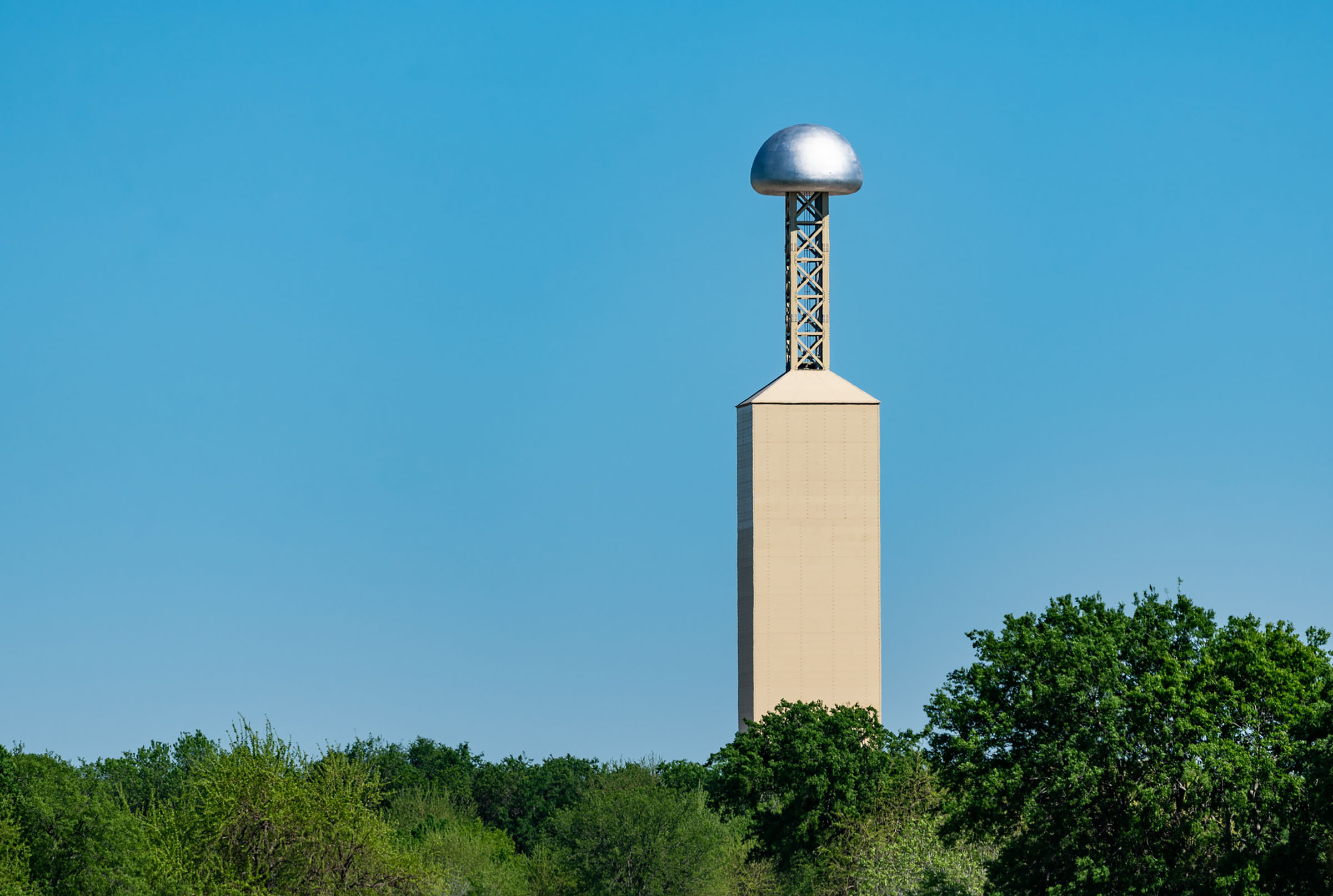
Travelers on Interstate 35 between Dallas and Waco may recognize the tower outside of Milford. Photo by Tony Webster, courtesy Flickr. CC BY 2.0.
About 50 miles south of downtown Dallas on Interstate 35—when the strip malls of the metroplex give way to cornfields—a strange tower stands sentry over an empty field. Texas travelers familiar with the sight of water towers peppering stretches of highway will have trouble placing this structure: It looks more War of the Worlds than Friday Night Lights.
A rectangular piece of concrete forms the base of the tower, which holds a skinny pillar of metal topped with a silvery disc, the exact shape of the UFO that descends to drop E.T. off in a forest. Far from otherworldly, this tower, perched just outside of the tiny town of Milford, hearkens back to the Wardenclyffe Tower built in the early 20th century.
Erected in 1901-05 by inventor and futurist Nikola Tesla, Wardenclyffe Tower graced the shores of Long Island, New York. Tesla held high hopes for his invention; he intended for it to transmit energy and correspondence from the United States across the ocean to Europe. He wanted it to serve as a rival to the radio-based telegraph system. Sadly, Tesla’s grand plans never came to pass. The project’s primary funder, John Pierpont Morgan, lost interest—or faith—in the tower, and Tesla never found another believer to invest. Wardenclyffe Tower stood abandoned for more than a decade until it was sold for scrap in 1917.
Milford’s tower shares a similar trajectory. In 2018, Waco-based Viziv Industries tried to harness a phenomenon called Zenneck surface wave to transmit electromagnetic waves through the air. The idea was that this new technology would provide safe, efficient, and inexpensive electrical power without the need for the electric grid. A 2019 Channel 25 KXXV News report viewable on YouTube provides a frankly adorable news clip asking the locals what they think of the new tower looming in their community’s backyard. A woman standing with her daughter asks, “We did think, are we going to be glowing people?” Another local muses about its appearance: “We were thinking we’re going to walk around with tin foil on our head.” A Viziv representative assures the news anchor that tin foil hats were unnecessary, and that the tower is simply a new scientific innovation. But did it work, I wondered, and so began a completely unsuccessful round of phone calls.
A little internet sleuthing informed me that Viziv Technologies filed for bankruptcy in 2021. No luck there. I tried Milford’s City Hall, where a kind woman assured me that she didn’t know much about the tower, other than this was an “Ellis County deal,” not a Milford one. (Milford is in Ellis County, the county seat of which is Waxahachie.) I left a message for the Ellis County communications representative, who didn’t return my call. An article about a partnership with Baylor University spurred a call to Waco that proved equally futile. Perhaps this was something that required an in-person visit.
It’s a testament to the boredom of my octogenarian father that he jumped at the chance to accompany me on the drive to Milford during Dallas’ rush hour on a Monday afternoon in August. He’s a former pharmaceutical executive with a doctorate in analytical chemistry and, for a brief time in the late 1960s, was a high school physics teacher. I figured he could enlighten me on the theory of how, and if, the Milford-Viziv tower might work. We headed south, air conditioning blasting against the triple-digit heat outside. The fields along the highway looked like they’d been air-fried, brown and crisp, but we kept our eyes toward the horizon as we discussed politics and family lore and his time at The University of Texas at Austin.
Milford feels small even to this small-town girl. According to the town’s website, settlers started coming in the 1850s. Men from Cherokee County purchased land from Arvin Wright “at 50 cents an acre,” moving their families to the area just south of Mill Creek. The website’s account of history is scant but evocative. For example, Milford housed a community hall/ schoolhouse/church that burned down during the Civil War. It once boasted a gristmill and even a Presbyterian college before the Great Depression led to a population decline. In more recent news, a Chevron gas station explosion caused the residents to evacuate town in 2013. Driving down Main Street, I’m reminded a bit of my hometown of Mansfield, which used to be tiny and is now a bustling suburb. Here, however, the downtown buildings are beautiful, but mostly empty. There’s a general store offering cold Topo Chico and packed snacks, a seemingly one-room post office, and a few stunning Victorian homes I was desperate to peek inside.
I tried to get someone from Milford to talk to me about the tower. I asked the friendly woman at the general store who looked at me baffled by what I was describing. The next town over, the sweet, middle-aged clerk at the register also apologized for not knowing what I was referring to. Dad and I were disappointed we couldn’t get a local’s take. I was hoping for some great story about teenagers spray painting its concrete base with “Go Milford Bulldogs,” but alas, we heard nothing of the sort. We wanted one last look, so I pulled to the side of I-35 to snap a pic on my phone. “What do you think it looks like?” I asked my dad.
“Maybe a jellyfish on a water tower. It kind of resembles a toilet plunger.”
“I don’t think it looks like a toilet plunger at all,” I replied. My dad shrugged. I asked him if he thought it would work, hypothetically. He said, “It would work if the receiving grid was close enough probably. You could say that would test the performance of inverse square laws. The power of the energy they send out on that thing is reduced by one over the square of the distance away.” An English major, I’m suddenly reminded of why I never asked my dad for help with my math or science homework; his answers went right over my head.
I started the car to head back, then pulled over at a gas station after he insisted I fill up my already half-full tank.
“Look!” my dad elbowed me as we pulled away. A row of Tesla charging stations lined the parking lot. “Tesla both in front and behind us!” And like Nikola Tesla’s dream of airborne electricity, the Milford tower shrank in my rearview mirror.








